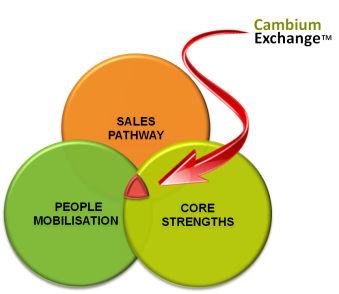How to scale-up & ensure the sustainable growth of your business in B2B markets?
 Entreprenuerial leaders seeking to scale-up and ensure the sustainable growth of their business may remember being taught this proverb as a child at school:
Entreprenuerial leaders seeking to scale-up and ensure the sustainable growth of their business may remember being taught this proverb as a child at school:
“Great (or tall) oaks from little acorns grow”
Your teacher probably used it to explain that even the greatest ideas or mot ambitious projects have humble beginnings on a small scale.
The natural role of the Cambium in scalable growth
In a literal sense it is the Cambium within the ‘great oak’ that enables the tiny acorn to achieve its lofty status and grandeur. Today the word Cambium is most often used in the field of Botany to describe the layer of cells that are the source secondary growth in woody plants, such as trees.
You will certainly have seen the legacy of the Cambium on the chair you are sitting upon or in surface of the table that you are resting your computer upon to read this blog. The Cambium leaves a legacy every year, as it provides the leading edge of growth in a tree, which creates the ‘growth rings’ that you see in wood. It is this sustainable, annual growth of the Cambium that expands the tree trunk and which in turn creates the strength and the structure that supports the tallest oaks.
Scaling the sustainable growth of early stage businesses
This back story explains why we use Cambium to describe our business – Cambium LLP. One of our service offerings called the Cambium Exchange™ addresses the needs of early stage businesses, to support the accelerated adoption of their ideas (acorns) in business markets.
In nature the Cambium only comes into its own, once the plant has gone past its initial growth stage and has survived long enough to be a sapling. For this reason we do not focus upon pre-revenue start-up companies, but have our greatest impact once the business has acquired a small number of customers and has transitioned from a seed to a sapling. It is at this ‘sapling’ stage that the emergent business begins to have a number of “growing pains”.
What do we mean by “growing pains”?
These growing pains manifest themselves as tensions that typically occur at this point. Symptoms may include:
- A shortage of resources e.g. people or funding
- Differences of opinion over business direction and strategy
- Poor communication across the growing business as it expands its scope of operations to meet the demands of its customers
It is precisely at this point that the ‘sapling’ business begins to mature and needs some support, strength and structure to underpin its sustainable growth into a larger, enduring, and successful enterprise.
The relevance of Cambium to early stage businesses
In Latin cambium translates into the verb – to exchange.
The word, exchange, has many meanings, we often think of it in terms of its financial connotations to exchange shares or money, as evidenced by the ‘Cambio’ signs, we see during our holidays. The Botanists choice of the word was due to the function that the Cambium cells facilitate in the growing structure of a plant, which is to allow the exchange of important nutrients between the many other cells important for the growth of the plant. This definition of the word exchange, is described by various dictionaries as the ability:
“to give and receive reciprocally; to make an exchange of; to interchange“ – Oxford English dictionary
“to give up or give up in return for something else” – Chambers Twentieth Century dictionary
It is these definitions that have great relevance to our specialism of accelerating the growth of early stage sustainable businesses.
Why do so many early stage businesses experience “growing pains“?
In our experience one of the primary reasons why so many early stage innovative businesses encounter problems is due to the evolution of skills that are needed within the emerging business to support the innovation’s transition from the laboratory or drawing board to achieving successful adoption by the market. This evolution in expertise is challenging because of the tensions within the business that it creates, evidenced in:
- Disagreements over the opportunities that the business should exploit and the direction it should take
- An inability to know what skills are needed to be successful
- Divergence in the experience and motivations of the key players in the business, which result in different perceptions of the problems afflicting the business as each individual views the business through their own individual lens.
Often these issues result in internal debate, lack of focus and spreading very finite resources too thinly. Companies in this phase of growth may spend too much valuable time on internal differences rather than winning in the market.
It is at this precarious point, when the stakes and tensions are at their highest, when the future of the business is on a knife edge, that the key players in the business need support to work through these very real difficulties.
Cambium = Exchange
At this vital point in a businesses evolution the key requirement is an ability to communicate and to discuss the status of the business openly, rationally and objectively. This vital debate needs both time and a place to work through the issues. Ideally participants need to approach the discussion with the same spirit of optimism, open mindedness and camaraderie that prevailed when the business was first established.
At such key times it often helps to have independent facilitation of this debate to ensure that all voices are heard and to pose key questions without fear or favour. In other words to create an environment, where the participants can:
- give and receive their ideas reciprocally
- make an exchange of their fears and concerns and to interchange thoughts and views on potential solutions
- to give up their deeply held views on issues or give up these positions in return for the survival and success, of the business
For these reasons our core diagnostic tool for identifying the barriers to sustainable growth is called the Cambium Exchange as it  creates both the environment and poses the right questions that need to be answered in order to support our clients in gaining consensus upon:
creates both the environment and poses the right questions that need to be answered in order to support our clients in gaining consensus upon:
- A common view of what success looks like
- The key impediments to achievement of these goals
- The best strategies to take forward in pursuit of these objectives
- The key skills needed to ensure success
- The actions and ownership needed to implement the plan for growth and market success







